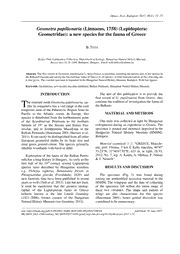
Geometra papilionaria (Linnaeus, 1758) (Lepidoptera: Geometridae): a new species for the fauna of Greece PDF
Preview Geometra papilionaria (Linnaeus, 1758) (Lepidoptera: Geometridae): a new species for the fauna of Greece
Opusc. Zool. Budapest, 2017, 48(1): 71–73 Geometra papilionaria (Linnaeus, 1758) (Lepidoptera: Geometridae): a new species for the fauna of Greece B. TÓTH Balázs Tóth, Lepidoptera Collection, Department of Zoology, Hungarian Natural History Museum, Baross utca 13, H–1088, Budapest, Hungary. Email: [email protected] Abstract. The first record of Geometra papilionaria L. from Greece is provided, extending the known area of the species in the Balkan Peninsula and raising the Geometrinae fauna of Greece to 18 species. A brief characterisation of the collecting site is also given. The voucher specimen is deposited in the Hungarian Natural History Museum, Budapest. With two figures. Keywords. Geometrinae, new record, macchia shrubland, Balkan Peninsula, Hungarian Natural History Museum INTRODUCTION The aim of this publication is to provide the first record of G. papilionaria from Greece, thus Th e emerald moth Geometra papilionaria, un- continue the tradition of investigation the fauna of like its congeners, has a vast range in the cool the Balkans. temperate zone of the Palaearctic Region from its Pacific to the Atlantic coasts. In Europe, this MATERIAL AND METHODS species is distributed from the northernmost point of the Scandinavian Peninsula to the northern One male was collected at light by Hungarian latitude of 39° in the Iberian and Italian Pen- coleopterists during an expedition to Greece. The insulae, and to Southeastern Macedonia in the specimen is pinned and mounted, deposited in the Balkan Peninsula (Hausmann 2001, Huemer et al. Hungarian Natural History Museum (HNHM), 2011). It can easily be distinguished from all other Budapest. European geometrid moths by its large size and deep green ground-colour. The species primarily Material examined. 1 ♂: "GREECE, Makedo- inhabits woodlands with birch or alder. nia, pref. Florina, 5 km E Kella macchia, 40°47' 53.23"N, 21°46'07.95"E, 635 m, at light, 26.VI. Exploration of the fauna of the Balkan Penin- 2012, No. 7, leg. A. Kotán, A. Márkus, P. Nemes sula has a long history in Hungary. As early as the & T. Németh". first half of the 19th century several Lepidoptera species were described by Hungarian scientists RESULTS AND DISCUSSION e.g. Plebejus sephirus, Behounekia freyeri or Phragmatobia placida (Frivaldszky 1835) and The specimen (Fig. 1) was found during new faunistic data have been published in recent sorting out unidentified accession material in the years as well (Tóth et al. 2013). Last but not least, HNHM. The wingspan and the date of collecting it must be mentioned that the greatest monog- of the specimen fall within the mean range of rapher of the Lepidopteran fauna of Greece these two variables. The shape and pattern of hitherto known is the late László Gozmány wings are also characteristic for this species (1921–2006), former curator of the Hungarian (Hausmann 2001), hence genital dissection was Natural History Museum (see Gozmány 2012). considered to be unnecessary. _______________________________________________________________________________________________________ urn: lsid:zoobank.org:pub:3CFE3FD1-E6B5-4825-8481-FEA91D7D8325 published: 30 June, 2017 HU ISSN 2063-1588 (online), HU ISSN 0237-5419 (print) http://dx.doi.org/10.18348/opzool.2017.1.71 Tóth: Geometra papilionaria: a new species for the fauna of Greece Figure 1. Image of Geometra papilionaria L. from Greece. Figure 2. Distribution of G. papilionaria in the Balkan Peninsula; grey dots are from Hausmann (2001) and Huemer et al. (2011), the new record from Greece is marked by black square. The collecting site is situated at the southern Mediterranean macchia shrubland, which is high- foothills of the Kaimaktsalan Mountains, ca. 15 ly atypical for this species. The closest suitable km south of the Greek-Macedonian border, close habitats, i.e. montane beech forests or cool to Vegoritida Lake (Fig. 2). The habitat type is stream-valleys with alder, can be found several 72 Tóth: Geometra papilionaria: a new species for the fauna of Greece kilometres away, therefore the specimen was Acknowledgements – I am indebted to Dr Zsolt Bálint likely showing dispersal behaviour. This pheno- for the critical review of the manuscript. I am grateful to Mr Gergely Katona for the help of taking photographs of the G. menon could rarely appear according to faunistic papilionaria specimen and to Mr Tamás Németh, one of the data of the HNHM collection. collectors of the specimen, for valuable information on the collecting site. All of them are staff members of the HNHM. As this species regularly comes to light, the method of collection is ordinary. REFERENCES This record represents the southernmost FRIVALDSZKY, I. (1835): Közlések a ’Balkány’ vidé- locality of G. papilionaria in the Balkan Penin- kén tett természettudományi utazásról [Contribu- sula, raising the number of Geometrinae species tions on the scientific expedition to the Balkan occurring in Greece to 18. region – in Hungarian]. A Magyar Tudós Társaság Évkönyvei, 2: 235–276. Magyar Királyi Egyetem, Checklist of the subfamily Geometrinae in Buda. Greece. Taxa are listed in systematic order according to Hausmann (2001): GOZMÁNY, L. (2012): The Lepidoptera of Greece and Cyprus, volume 1. Hellenic Zoological Society, Aplasta ononaria (Fuessly, 1783) Athens, pp. 414. Pseudoterpna pruinata (Hufnagel, 1767) Pseudoterpna coronillaria cinerascens (Zeller, 1847) HAUSMANN, A. (2001): Introduction. Archiearinae, Geometra papilionaria (Linnaeus, 1758); new record Orthostixinae, Desmobathrinae, Alsophilinae, Comibaena bajularia ([Denis & Schiffermüller], 1775) Geometrinae. In. HAUSMANN, A. (Ed.) The geo- Proteuchloris neriaria (Herrich-Schäffer, 1852) metrid moths of Europe 1: 1–282. Thetidia smaragdaria (Fabricius, 1787) Hemistola chrysoprasaria (Esper, 1795) HUEMER, P., KRPAČ, V., PLÖSSL, B. & TARMANN, G. Xenochlorodes olympiaria (Herrich-Schäffer, 1852) (2011): Contribution to the fauna of Lepidoptera of Eucrostes indigenata (de Villers, 1789) the Mavrovo National Park (Republic of Mace- Jodis lactearia (Linnaeus, 1758) donia). Acta Entomologica Slovenica, 19 (2): 169– Thalera fimbrialis (Scopoli, 1763) 186. Hemithea aestivaria (Hübner, 1789) Chlorissa viridata (Linnaeus, 1758) TÓTH, B., BABICS, J., & BENEDEK, B. (2013): Contri- Chlorissa cloraria (Hübner, 1813) butions to knowledge of the geometrid fauna of Phaiogramma etruscaria (Zeller, 1849) Bulgaria and Greece, with four species new for the Phaiogramma faustinata (Millière, 1868) Greek fauna (Lepidoptera: Geometridae). Espe- Microloxia herbaria (Hübner, 1813) riana, 18: 221–224, plate 12. 73
